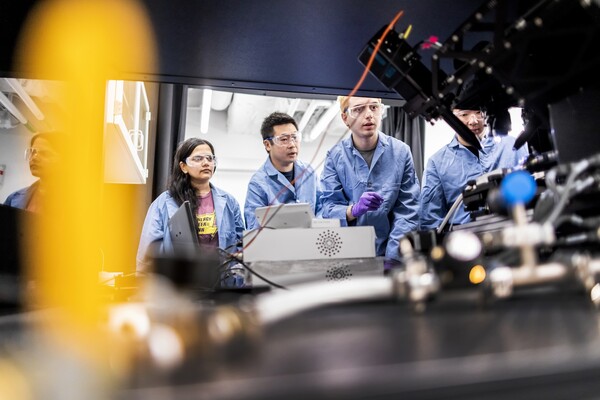
nocred
Groundbreaking research was abundant at Penn in 2017. As the year draws to a close, here’s a look back at a few of the innovative studies University researchers published this calendar year:
Popularity contest: What makes a piece of content go viral? Using fMRI scans, Christin Scholz, Elisa Baek, and Emily Falk of the Annenberg School for Communication studied the brain activity of 80 people while those participants read abstracts and headlines from dozens of New York Times health-related articles. The researchers discovered that when participants were deciding which articles to read and share, they thought about both themselves and their social networks, not simply one or the other. In addition, they found that the ventromedial prefrontal cortex and ventral striatum—parts of the brain implicit in decision-making, risk, and reward—come together to indicate a piece of content’s value.
Tough love: A puppy’s experiences early in life, particularly his relationship with mom, affect his behavior as an adult dog, according to findings published in June in the Proceedings of the National Academy of Sciences. Researchers from the schools of Veterinary Medicine and Arts and Sciences observed 23 mother dogs and 98 puppies for the first five weeks of life at The Seeing Eye, an organization that trains guide dogs for the blind. They found that pampered pups, those whose moms paid closer attention to their every need, were less likely to complete the training program. “With mothering,” says lead researcher Emily Bray, “it’s a delicate balance.”
Mouth matters: This past July, researchers from the School of Dental Medicine, led by Vice Dean of Scholarship and Research Dana Graves, published about a concrete link between diabetes and the oral microbiome. Comparing healthy mice to those with diabetes, the team discovered that when blood-sugar levels of those in the latter group spiked, their microbiome changed, becoming distinct from that of their normal littermates. That shift led the diabetic mice to develop a gum disease called periodontitis, which harms the bones that support teeth. “Diabetes is one of the systemic diseases most closely linked to periodontal disease, but the risk is substantially ameliorated by good glycemic control,” Graves says. “Good oral hygiene can take the risk even further down.”
Keeping the faith: Research has shown that fewer than two thirds of African-American new moms initiate breastfeeding, and just 14 percent continue the practice for the first six months of her baby’s life. School of Nursing’s Diane Spatz and Camilia Kamoun, formerly of the Perelman School of Medicine, wanted to understand whether incorporating faith—in this case, Islamic traditions for African-American Muslims—could positively influence a mother’s decision to breastfeed. Their study, published in June in the Journal of Human Lactation, found that in general, education about Islamic perspectives on breastfeeding wasn’t prevalent, but when it was included, it improved a woman’s attitudes about feeding her child in this way.
Legal mindset: A defendant’s state of mind at the time of a crime is crucial in determining the appropriate degree of blame and punishment. The law distinguishes those who knew legally relevant circumstances with certainty (termed “knowledge”) from those simply aware of a high probability that those circumstances existed (termed “recklessness”). But this difference is hard for juries to apply. Research published in February in the Proceedings of the National Academy of Sciences by Penn Law Professor Stephen Morse and colleagues in the MacArthur Research Network on Law and Neuroscience showed that brain imaging scans can predict such a mental state. Though the work lent support to the way the law distinguishes between knowing and reckless mind frames, the authors caution that the methodology is not yet ready for practical use.
Social strategy: The Common Core State Standards, put in place in 2009 to level the playing field in educational settings across the United States, also spur much debate—whether it’s the right approach, how it should be changed, which groups it alienates. Common Core also came about in the digital age, one in which Twitter gives a megaphone to almost anyone who wants one. To see how this online debate played out, Jonathan Supovitz and Christian Kolouch of the Graduate School of Education, with colleagues from the University of California, San Diego, and Universidad Nacional de Educación a Distancia in Madrid, Spain, analyzed one million tweets about Common Core posted between September 2013 and April 2016. They learned that savvy participants—those who resourcefully use the medium and frame their arguments to leverage relationships—spread their message most effectively.
Copying nature: The shells of giant clams appear iridescent, with cells on the surface scattering the bright sunlight they attract. Under different circumstances, this could damage the mollusk, even fatally. Instead, the clams convert the light into biofuel, a process Alison Sweeney, an assistant professor of physics in the School of Arts and Sciences, and Shu Yang, a professor of materials science and engineering in the School of Engineering and Applied Science, aimed to mimic. They did so by synthesizing nanoparticles, then adding them to a mixture of water, soil, and surfactants (soapy molecules), which created microbeads that copied the behavior of the iridocytes, the cells that guide this process in giant clams. Says Sweeney: “It’s exciting to see the clever, non-intuitive ways that life has come up with to solve problems.”
Location counts: Are online retail options harming local brick-and-mortar retail stores? That’s the question Lindsay Relihan, an applied economics doctoral student in the Wharton School, addressed through a study looking at the effect of online grocery shopping on coffee shops. By analyzing the credit and debit card transactions of millions of anonymized consumers, she discerned that “high-use early adopters”—those who started regularly using an online grocery platform soon after it became available in their city—reduced spending at physical grocery stores by 4.5 percent, but increased coffee-shop spending by about 7.6 percent during the following two years. The results suggest that consumers reorganize their shopping trips and potentially use the time saved by buying food online to increase their visits to nearby coffee shops, which Relihan says is a “win” for such physical stores that complement online retailers.
Avoiding a collision course: “When a city expands, it almost always destroys what’s in its way,” says Richard Weller, a professor in Penn’s School of Design and a fellow in the Penn Institute for Urban Research. Now is the time to take pains to prevent the expected population growth—3 billion additional city dwellers by 2100—from completely wiping out the biodiversity in its path, and Weller has done his part, with the “Atlas for the End of the World,” a three-year research project that culminated in hundreds of maps analyzing three-dozen biodiversity hotspots. As of 2017, fewer than half of those places have protected the 17 percent of land designated in United Nations conservation targets; to meet those goals, almost 700,000 additional Central Parks would need to be secured in the next three years, he found.
Domestic violence: A weapon, whether a body part such as hands, fists, and feet, or an external instrument like a gun, often accompanies intimate-partner violence. Susan B. Sorenson, a professor in the School of Social Policy & Practice and director of the Evelyn Jacobs Ortner Center on Family Violence, wanted to better understand just how frequently each type generally, and guns specifically, appeared. In collaboration with the Philadelphia Police Department, she studied more than 35,000 domestic-violence incidents from 2013. She found that assailants used hands, fists, or feet to attack in about 6,500 of them, and in nearly 1,900 used external weapons such as knives, scissors, or baseball bats. About one-third of events with external weapons involved a gun, and 80 percent of such incidents were male-on-female. She published her findings in the Journal of Women’s Health this past March.
Historic breakthroughs: Twice this year, the Food and Drug Administration approved gene therapies developed by researchers in the Perelman School of Medicine and at the Children's Hospital of Philadelphia. The first, in August, helps treat a specified group of children and young adults up to age 25 who have acute lymphoblastic leukemia. The second, approved earlier this week, targets a rare, inherited type of retinal blindness by injecting a corrective gene directly into the eye. Both approvals are notable: the former was the first-ever in the field of cancer immunotherapy, the latter the first for a genetic disease in the United States.
Michele W. Berger

nocred

Image: Pencho Chukov via Getty Images

The sun shades on the Vagelos Institute for Energy Science and Technology.
nocred

Image: Courtesy of Penn Engineering Today